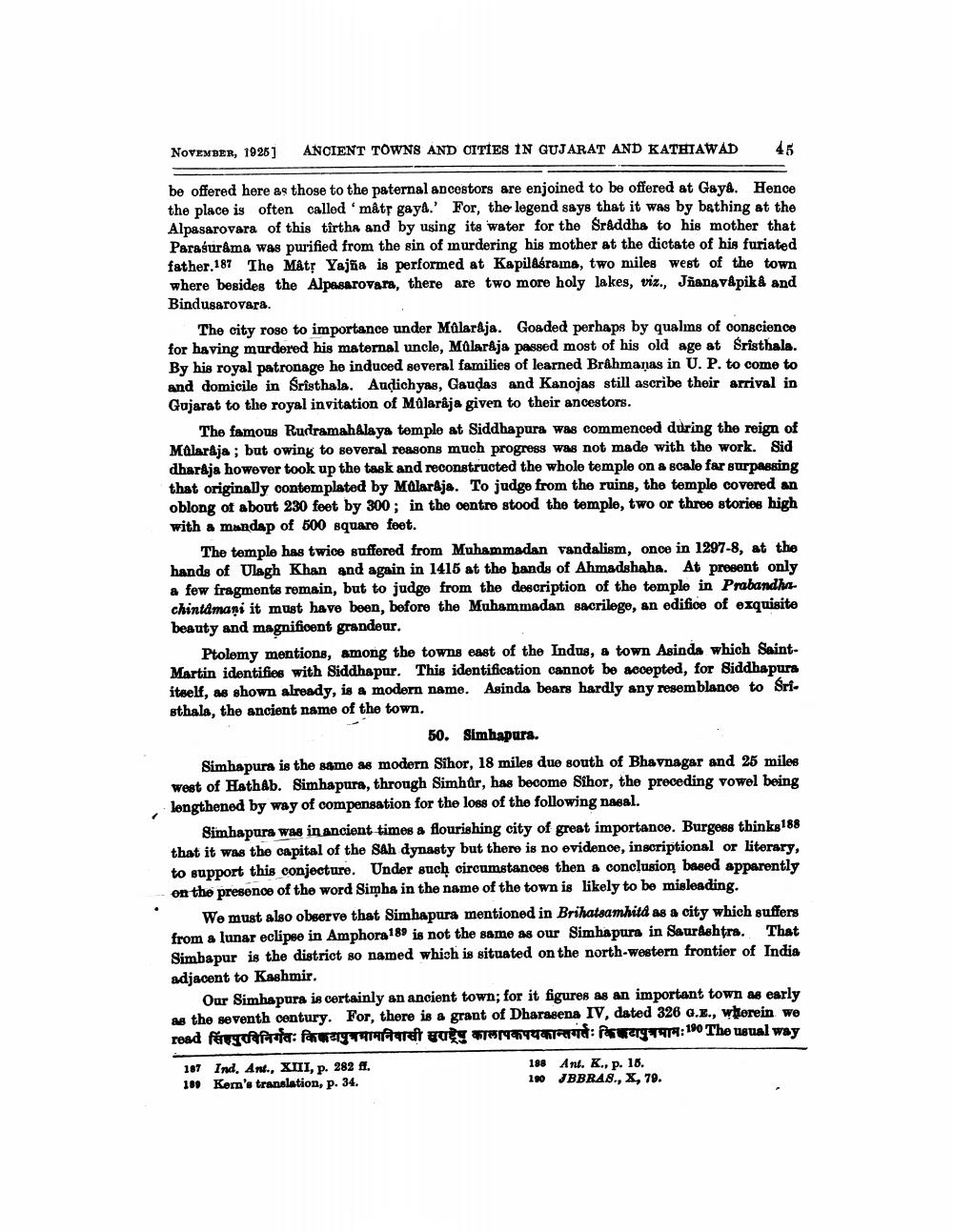________________
NOVEMBER, 1025]
ANCIENT TOWNS AND CITIES IN GUJARAT AND KATHTAWAD
45
be offered here as those to the paternal ancestors are enjoined to be offered at Gay&. Hence the place is often called 'mâts gaya.' For, the legend says that it was by bathing at the Alpasarovara of this tîrtha and by using its water for the Sraddha to his mother that ParagurAma was purified from the sin of murdering his mother at the dictate of his furiated father.187 The Matr Yajñia is performed at KapilAśrams, two miles west of the town where besides the Alpasarovara, there are two more holy lakes, viz., Jñana v&pik& and Bindusarovara.
The city rose to importance under Malaråja. Goaded perhaps by qualms of conscience for having murdered his maternal uncle, Mälar&ja passed most of his old age at Sristhala. By his royal patronage he induced several families of learned Brahmanas in U. P. to come to and domicile in Sristhala. Audichyas, Gaudas and Kanojas still ascribe their arrival in Gujarat to the royal invitation of Málarája given to their ancestors.
The famous RudramahAlaya temple at Siddhapura was commenced during the reign of Málarája; but owing to several reasons much progress was not made with the work. Sid dharaja however took up the task and reconstructed the whole temple on a scale far surpassing that originally contemplated by Molardja. To judge from the ruins, the temple covered an oblong of about 230 foot by 300; in the centre stood the temple, two or three stories high with a mandap of 500 square feet.
The temple has twice suffered from Muhammadan vandalism, once in 1297-8, at the hands of Ulagh Khan and again in 1415 at the hands of Ahmadshaha. At present only a few fragments remain, but to judge from the description of the temple in Prabandhschintamani it must have been, before the Muhammadan sacrilege, an edifice of exquisite beauty and magnificent grandeur.
Ptolemy mentions, among the towns east of the Indus, a town Asinds which SaintMartin identifies with Siddhapur. This identification cannot be accepted, for Siddhapura itself, as shown already, is a modern name. Asinda bears hardly any resemblance to Sri. sthala, the ancient name of the town.
50. Simhapura. Simhapura is the same as modern Sihor, 18 miles due south of Bhavnagar and 25 miles West of Hathab. Simhapura, through Simhûr, has become Sihor, the preceding vowel being lengthened by way of compensation for the loss of the following nasal.
Simhapura was in ancient times a flourishing city of great importance. Burgess thinkg188 that it was the capital of the Sah dynasty but there is no evidence, inscriptional or literary, to support this conjecture. Under such circumstances then a conclusion based apparently on the presence of the word Simha in the name of the town is likely to be misleading.
We must also observe that Simhapura mentioned in Brihatsamhitd as a city which suffers from a lunar eclipse in Amphora 189 is not the same as our Simhapura in Saurashtra. That Simbapur is the district so named which is situated on the north-western frontier of India adjacent to Kashmir.
Our Simhapura is certainly an ancient town; for it figures as an important town as early as the seventh century. For, there is a grant of Dharasena IV, dated 326 G.E., wherein we read farscaparata: fairy magret og 1994 fra 1974:190 The usual way
187 109
Ind. Ant., XIII, p. 282 ff. Ker's translation, p. 34.
188 180
Ant. K., p. 18. JBBRA8., X, 79.




